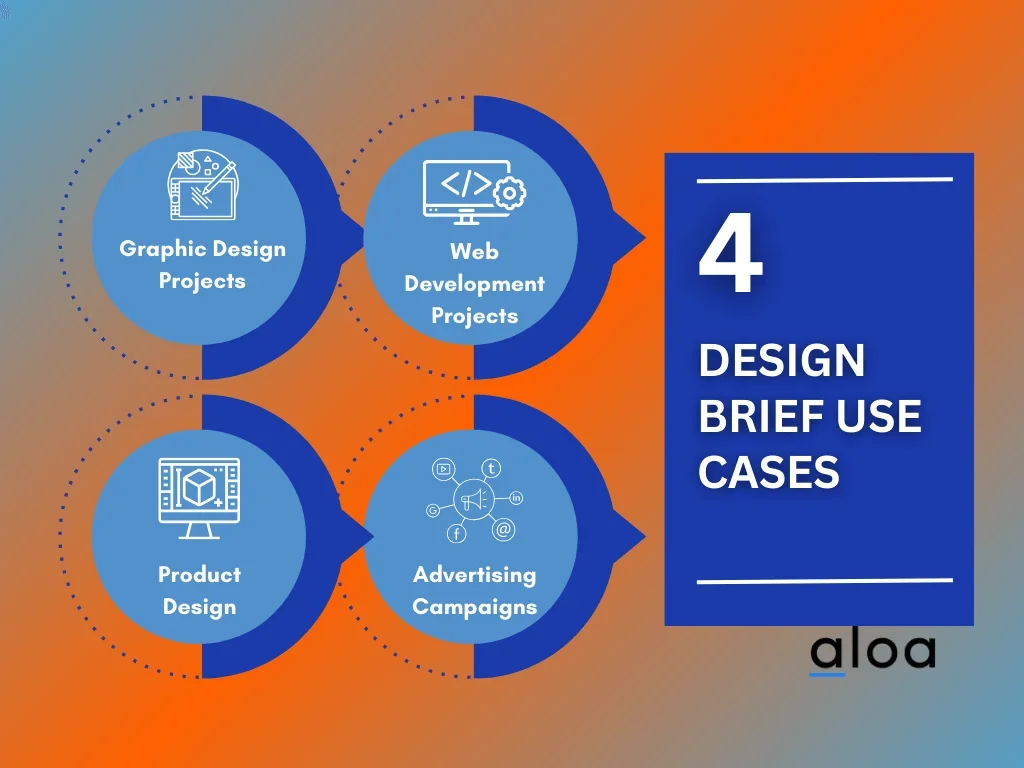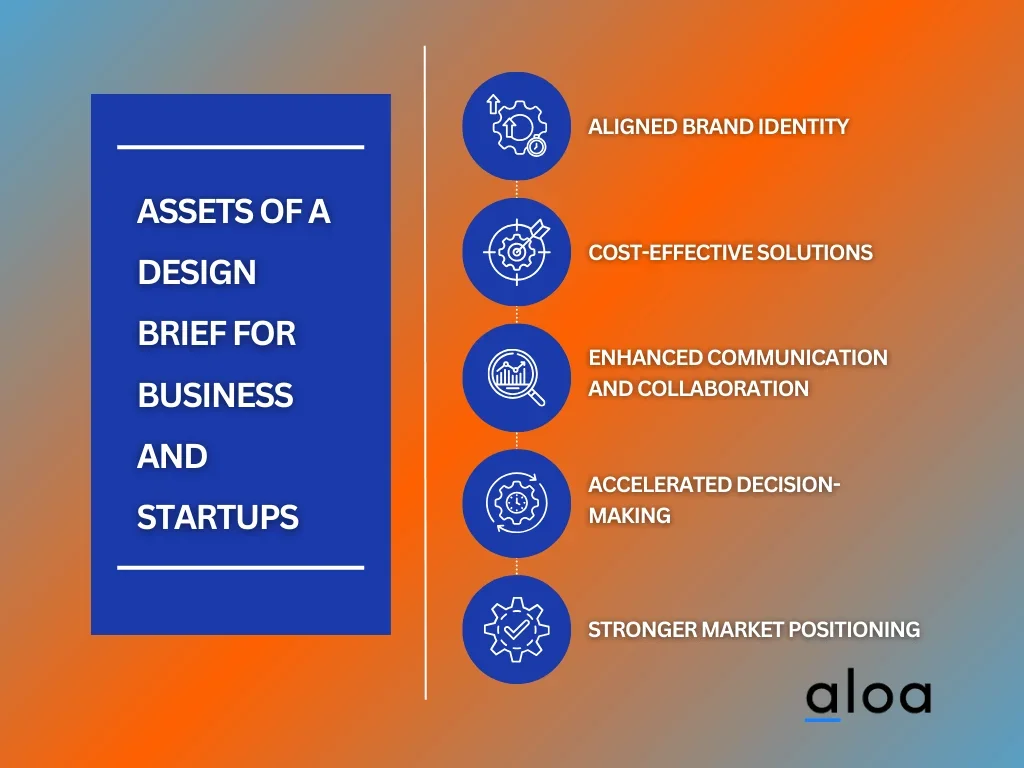A design brief is a roadmap for businesses and startups, guiding the visual aspects of a brand. It facilitates clear communication, efficient resource management, and the creation of visually appealing materials, all essential for building and maintaining a good brand reputation.
Aloa, a software outsourcing expert, underscores the significance of clear communication in successful projects, especially if you're running your own business and want to make a great impression that can lead to your work being recommended. Working with many startups and enterprises taught us how crucial good design is.
Design is essential for engaging and convincing people to get involved. It attracts people to a brand and helps turn complex ideas into projects that deeply resonate with your audience.
In this blog, we’ll discuss design briefs: what they are, how to create an effective one, and when and how to use them in various situations. We'll simplify the process for you, making it easy to understand the critical components of design briefs and how they work. We'll also explore real-life examples to help you see their practical applications.
By the end, you'll clearly understand design briefs and how they can be game-changers for your creative projects.
Let the journey begin!
What Is a Design Brief?

A design brief is like a blueprint outlining the purpose, limits, and direction of a creative project. It serves as the digital link between the client and the designer, encapsulating the reasoning behind the new design, its effect on the audience and brand, and its competitive advantage.
Within this digital manuscript, you find the intricate details: what’s to be crafted, the financial confines, temporal constraints, and the project’s overall reach. It's all about syncing expectations, ensuring a seamless digital dance where client satisfaction and design team ingenuity merge effortlessly.
At the core of every project brief, there reside essential elements that shape its essence and purpose:
- Project Overview: The overview provides a detailed description of the design project, outlining its purpose, context, and any relevant background information, enabling both the client and the designer to understand the project's essence and significance.
- Objectives: They outline the specific and measurable goals the design project aims to achieve, serving as a roadmap for the design process and ensuring a clear focus on what needs to be accomplished.
- Target Audience: Describing the intended audience's demographics, preferences, and behaviors helps the designer tailor the creative elements to resonate effectively with the audience, ensuring the design's relevance and impact.
- Scope of Work: It defines the specific tasks, responsibilities, and boundaries of the design project, clarifying what is included and what is not, thus preventing misunderstandings and scope creep during the project.
- Deliverables: They specify the tangible items or outcomes the client expects from the design project, such as designs, files, or prototypes, providing clear expectations for the final results of the project.
- Constraints: They include limitations such as budget, time, or technical requirements, guiding the design process within practical boundaries and ensuring that the project remains feasible and realistic.
- Timeline: It establishes the project schedule, including key milestones, deadlines for reviews and revisions, ensuring a structured workflow and timely completion of the design project as per the client's expectations.
This clear and concise document sets the project's tone, promoting efficiency. Whether a small project or a significant initiative, a well-crafted project brief is a great way to steer the project toward its goals and ensure it becomes a roaring success.
How To Write an Effective Design Brief?
Writing a design brief marks the pivotal initiation of any project. To help you dive deeper, here's a comprehensive guide on crafting a design brief essential for laying the foundation for a successful project journey. Seven key steps are listed below to make a design brief that works:
Step 1: Understand the Project
Understanding your project is the first step in creating a detailed design brief. Start by meeting with stakeholders to understand their vision, goals, and expectations. It's crucial to have a clear understanding of the project's purpose.
This knowledge forms the foundation of your design brief. By exploring the project thoroughly and listening carefully, you can identify objectives, target audience, and potential challenges. This step ensures that your design aligns perfectly with the project's goals, making your design brief more effective and meaningful.
Step 2: Define Clear Objectives
Once you've set the essential groundwork for your project in the first step, you can begin to clarify your project's goals. As you draft the objectives of your project, keep in mind measurable and specific key performance indicators or KPIs.
To illustrate, if the project goal is to increase brand visibility, a particular objective could be to boost website traffic by 30% within the next six months. This objective is clear, measurable, and aligns with the overarching goal of enhancing brand visibility.
Step 3: Know Your Audience
With your objectives in place, understand your target audience through market research. Define their demographics, preferences, and behaviors. Insight into the audience helps tailor the design to resonate effectively with the intended users.
For example, if one of the objectives is to enhance user engagement, a specific KPI could be to increase the average time spent on the website from 2 to 4 minutes within three months. Understanding this metric helps craft user experiences that directly impact engagement levels.
This understanding forms the essential elements for crafting a design brief geared toward the target audience. Below are the vital details for identifying the target audience for writing a design brief:
- Conduct user interviews to gather insights about users' needs, goals, and pain points.
- Differentiate between users, buyers, sellers, and administrators, each having unique user stories.
- Define the overarching user story, often an epic, articulating the high-level goal of the product from the user's perspective.
- Determine specific features within each module, focusing on the functionalities users need to accomplish their tasks.
- Break features into actions and sub-actions, capturing detailed user interactions with the product.
- Reformat actions into concise user stories following the template: "As a [user role], I want to [action] so that [benefit]."
- Ensure each user story clearly defines the user, the action they want to perform, and the benefit they expect.
These elements provide a focused and essential framework for understanding the target audience for a design brief.
Step 4: Set Scope and Constraints
The scope and constraints of the project should reflect the defined objectives and the target audience's needs. Clearly define the project's scope, including what is included and what is not. Specify constraints such as budget, time, and technical limitations. Understanding limitations is essential for realistic planning. Constraints, like the budget limit for the web development project, are established during this phase, ensuring realistic planning aligned with stakeholder expectations.
For example, if the objective is to launch a user-friendly mobile app, a specific constraint could be a budget limitation of $100,000. This constraint guides the project team in making decisions aligned with the defined objectives within the financial limits.
Step 5: Detail Deliverables and Requirements
With the project scope in place, specify the deliverables expected from the project. This could include design files, prototypes, or branding materials. Clearly outline specific requirements, such as preferred color schemes or design elements.
The objectives and specific KPIs serve as benchmarks here. Specify the deliverables and requirements with an apparent reference to the objectives and KPIs. For instance, if the aim is to improve conversion rates, a specific condition could be to design a streamlined checkout process that reduces cart abandonment rates by 20%. This requirement ensures the design team focuses on elements directly impacting the conversion rate KPI.
Step 6: Establish a Timeline
Once you’re done specifying the deliverables, create a detailed project roadmap with milestones and deadlines. Set precise dates for reviews, revisions, and the final delivery of the project. A well-structured timeline ensures everyone is on the same page regarding project progress.
To illustrate, if one of the objectives is to launch a new product line, a milestone could be to complete the product design and testing phase within two months. This timeline aligns with the objective and ensures that progress is measured against the specific KPIs related to the product launch.
Step 7: Encourage Collaboration and Feedback
Lastly, foster collaboration between stakeholders and the design team to enhance communication and cooperation throughout the project. Encourage open communication channels for feedback.
Regular check-ins and feedback loops become essential components. For instance, during a feedback session, stakeholders might evaluate the prototype based on the specific KPIs for user experience improvement. This targeted feedback ensures that design iterations are aligned with the measurable goals defined at the beginning of the project.
Effective onboarding practices set the foundation by introducing team members to project objectives and roles, ensuring clarity. Regular check-ins track progress, resolve issues, and maintain alignment with goals. Feedback loops enable timely, constructive input for iterative improvements, enhancing the quality of the project. Inclusive decision-making ensures all stakeholders actively contribute to project success, maximizing the value of communication and collaboration.
This seamless progression through each step, keeping measurable and specific KPIs in mind, ensures that the project remains focused, measurable, and aligned with its intended goals and objectives. Each step builds upon the previous, forming a solid continuum that leads to a successful design project.
When To Use a Design Brief?
A design brief is a versatile tool used across various creative industries. It ensures that creative projects stay focused, cohesive, and aligned with the desired outcomes. Here are some common use cases, highlighting the similarities, differences, features, and uses in different scenarios:

Graphic Design vs. Design Brief
Graphic design is the art and practice of planning and projecting ideas and experiences with visual and textual content. Designers create visual content such as logos, brochures, pamphlets, and poster design, focusing on print media, branding materials, and illustrations to convey a specific message or concept.
In contrast, a design brief is a comprehensive guide for designers, providing detailed insights into project goals, preferred color schemes, typography choices, and imagery styles. It serves as a roadmap, ensuring a clear understanding of client expectations and specific requirements for print materials and digital assets. Design briefs are essential tools that shape design projects' creative direction and outcome.
The main difference between graphic design and design briefs is what they do and how they work. Graphic design is like artwork - the creative process of making logos and posters look visually appealing.
Design briefs, on the other hand, are like detailed instructions. They tell designers precisely what the client wants regarding colors, fonts, and style. Think of graphic design as the painting and design briefs as the step-by-step guide to painting it. Graphic design is the art, and design briefs are the specific plan that ensures the art meets the client's needs.
Usually, graphic design creates visually engaging content like logos, flyer templates and posters, focusing on print media and branding. On the other hand, design briefs provide specific instructions to designers, outlining project goals, color schemes, and styles. They act as a roadmap, ensuring the final design aligns perfectly with the client's vision and needs.
Web Development vs. Design Brief
Web development involves the creation and maintenance of websites and web applications. Developers utilize various programming languages, frameworks, and tools to build functional and interactive websites. They focus on the technical aspects of website functionality, ensuring seamless user experience, efficient performance, and responsive design across different devices and platforms.
However, a design brief serves as a detailed document outlining the objectives and requirements of a website or web application project, including web design. It provides specific guidelines on features, user interface design, navigation structure, content organization, and interactive elements.
A well-crafted web development design brief acts as a blueprint, offering developers a clear understanding of the client's goals and expectations, technical specifications, and any unique functionalities needed for the project.
The main difference between web development and design brief lies in their roles. Web development involves constructing a functional website through coding and programming, ensuring a seamless user experience.
In contrast, the design brief provides specific instructions on the site's appearance and interactions, acting as a precise guide to align the website with the client's vision and requirements. Web development focuses on technical implementation, while design briefs shape the site's form and functionality to meet specific needs.
Usually, web development is used for constructing functional websites, focusing on coding and technical implementation to ensure a seamless user experience. Design briefs serve as detailed instructions, guiding the website's appearance and interactions, aligning it precisely with the client's vision and requirements. Web development brings the site to life, while design briefs shape its form and functionality to meet specific needs and objectives.
Advertising Campaigns vs. Design Brief
Advertising campaigns are strategic endeavors to promote products, services, or ideas to a target audience through various media channels. They involve the creation and execution of compelling messages and visuals that resonate with the audience's needs and preferences.
Advertising campaigns encompass a range of elements, including print and digital ads, social media content, video commercials, and more, all designed to deliver a unified message and achieve specific marketing objectives.
Conversely, a design brief is a foundational document that outlines the creative direction and critical parameters for an advertising campaign. It acts as a bridge between the client's goals and the innovative team's execution. A well-crafted design brief specifies the campaign's objectives, target audience demographics, messaging tone, and visual aesthetics. It guides the development of advertisements, ensuring that they align with the overall campaign strategy and effectively communicate the intended message.
The primary distinction between advertising campaigns and design briefs lies in their roles within the creative process. Advertising campaigns are dynamic and engaging presentations that reach the audience.
At the same time, design briefs are the strategic blueprints that guide the creation of these campaigns, ensuring they effectively convey the intended message and meet the client's marketing objectives. Advertising campaigns are the show, and design briefs are the behind-the-scenes playbook that brings the show to life.
Commonly, advertising campaigns promote products and ideas through engaging messages. Design briefs provide specific guidelines on goals and visual styles, acting as a roadmap for the campaign. Campaigns capture attention, while briefs ensure they align with client expectations.
Product Design vs. Design Brief
Product design is the meticulous process of conceptualizing, creating, and refining physical or digital products to meet user needs and enhance user experiences. Product designers blend aesthetics, functionality, and usability to develop visually appealing but also practical and user-friendly products. They consider materials, ergonomics, manufacturing processes, and technological integration to craft innovative and marketable products across various industries.
While, a design brief in product design acts as a foundational document that articulates the production process's vision, requirements, and constraints. It outlines the project's objectives, target audience, budget constraints, technical specifications, and desired features.
A well-defined design brief is a roadmap for product designers, providing clear guidelines and insights to shape their creative decisions throughout the design and development stages.
The key contrast between product design and design briefs lies in their functions within the design process. Product design is similar to the tangible outcome – the physical or digital product that users interact with.
It involves synthesizing creativity, engineering, and user-centric principles to produce a functional and aesthetically pleasing item. Product designers focus on form, usability, and user experience, ensuring the final product meets functional and aesthetic requirements.
Typically, product design creates innovative products for specific user needs. Design briefs provide particular instructions, guiding the product's goals, target audience, and features. They ensure the final product aligns with the client's vision, shaping the design process effectively. Product design innovates, while design briefs provide the necessary direction for success.
Assets of Design Brief For Business/Startups
A well-crafted design brief offers unique advantages for businesses and startups by guiding the creative process effectively and ensuring alignment with the company's vision and objectives. This not only boosts their competitiveness in the market but also sets them up for long-term success. Here are five specific assets:

Aligned Brand Identity
A design brief acts as a compass, guiding the creation of brand visuals and ensuring consistency across marketing materials, websites, and products. Startups can clearly define their brand’s personality, values, and target audience, allowing designers to craft visuals that resonate with the intended market. This alignment enhances brand recognition and strengthens the company's identity in the competitive market.
Cost-Effective Solutions
By outlining specific project requirements and constraints, a design brief assists businesses in managing budgets efficiently. Designers can work within predefined financial limits, avoiding unnecessary expenses. This targeted approach helps startups allocate resources wisely, ensuring cost-effective solutions without compromising quality.
Enhanced Communication and Collaboration
A design brief facilitates transparent communication between startups and creative teams. This is a reference point for all stakeholders, ensuring everyone understands the project's objectives and expectations. Clear communication minimizes misunderstandings, leading to seamless collaboration between the startup and designers.
Accelerated Decision-Making
A design brief encourages startups to define their goals and preferences early in the creative process. This clarity expedites decision-making as designers can present concepts and drafts that align with the brief and polish their initial ideas. Startups can make informed choices swiftly, reducing project timelines and allowing for timely implementation of marketing strategies or product launches.
Stronger Market Positioning
A well-crafted design brief helps startups articulate their unique selling points, target audience, and market positioning. Designers can incorporate these essential elements into visuals, creating a compelling brand presence. Consistent and appealing designs, rooted in a comprehensive brief, enhance the startup's credibility, making it more attractive to potential customers and investors.
A design brief empowers businesses and startups by providing a structured approach to creative projects. They ensure brand alignment, cost-effectiveness, streamlined communication, faster decision-making, and a compelling market presence, ultimately contributing to the startup’s success in the competitive business landscape.
Key Takeaway
A design brief is a comprehensive document outlining the core details of a creative project. Design briefs provide clarity, ensuring all stakeholders understand the project's objectives and enabling effective communication between clients and creative teams. By guiding the creative process, design briefs empower businesses and startups to transform ideas into impactful and visually appealing realities, fostering successful project execution and brand development.
Don't hesitate to contact [email protected] today, and let's begin crafting a design brief that genuinely reflects your objectives. This will facilitate seamless communication, enhance efficiency, and align perfectly with your goals. Our team will be there to guide you throughout the process, turning your ideas into tangible experiences. Let's get started and transform your concepts at your convenience.

